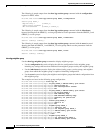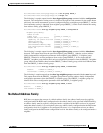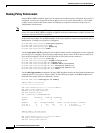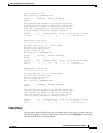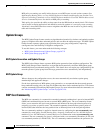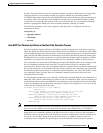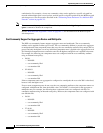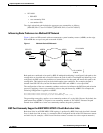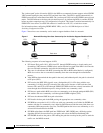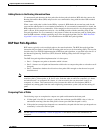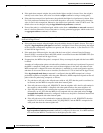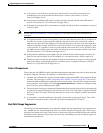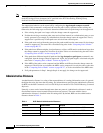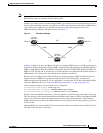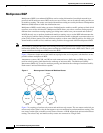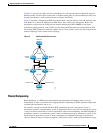
Implementing BGP on Cisco IOS XR Software
Information About Implementing BGP on Cisco IOS XR Software
RC-26
Cisco IOS XR Routing Configuration Guide
OL-14356-01
The “prebest path” point of insertion (POI) in the BGP cost community feature supports mixed EIGRP
VPN network topologies that contain VPN and back-door links. This POI is applied automatically to
EIGRP routes that are redistributed into BGP. The “prebest path” POI carries the EIGRP route type and
metric. This POI influences the best-path calculation process by influencing BGP to consider the POI
before any other comparison step. No configuration is required. This feature is enabled automatically for
EIGRP VPN sites when Cisco IOS XR software is installed on a PE, CE, or back-door router.
For information about configuring EIGRP MPLS VPNs, see Cisco IOS XR Multiprotocol Label
Switching Configuration Guide.
Figure 2 shows how cost community can be used to support backdoor links in a network.
Figure 2 Network Showing How Cost Community Can be Used to Support Backdoor Links
The following sequence of events happens in PE1:
1. PE1 learns IPv4 prefix 10.1.1.0/24 from CE1 through EIGRP running a virtual routing and
forwarding (VRF) instance. EIGRP selects and installs the best path in the RIB. It also encodes
the cost-extended community and adds the information to the RIB.
2. The route is redistributed into BGP (assuming that IGP-to-BGP redistribution is configured).
BGP also receives the cost-extended community from the route through the redistribution
process.
3. After BGP has determined the best path for the newly redistributed prefix, the path is advertised
to PE peers (PE2).
4. PE2 receives the BGP VPNv4 prefix route_distinguisher:10.1.1.0/24 along with the cost
community. It is likely that CE2 advertises the same prefix (because of the back-door link
between CE1 and CE2) to PE2 through EIGRP. PE2 BGP would have already learned the CE
route through the redistribution process along with the cost community value.
5. PE2 has two paths within BGP: one with cost community cost1 through multipath BGP (PE1)
and another with cost community cost2 through the EIGRP neighbor (CE2).
6. PE2 runs the enhanced BGP best-path calculation.
7. PE2 installs the best path in the RIB passing the appropriate cost community value.
8. PE2 RIB has two paths for 10.1.1.0/24: one with cost community cost2 added by EIGRP and
another with the cost community cost1 added by BGP. Because both the route paths have cost
community, RIB compares the costs first. The BGP path has the lower cost community, so it is
selected and downloaded to the RIB.
9. PE2 RIB redistributes the BGP path into EIGRP with VRF. EIGRP runs a diffusing update
algorithm (DUAL) because there are two paths, and selects the BGP-redistributed path.
10. PE2 EIGRP advertises the path to CE2 making the path the next hop for the prefix to send the
traffic over the MPLS network.
PE1 PE2
10.1.1.0/24
Back door
MBGP
CE3 CE4
CE1 CE2
CE1 CE2
210085



